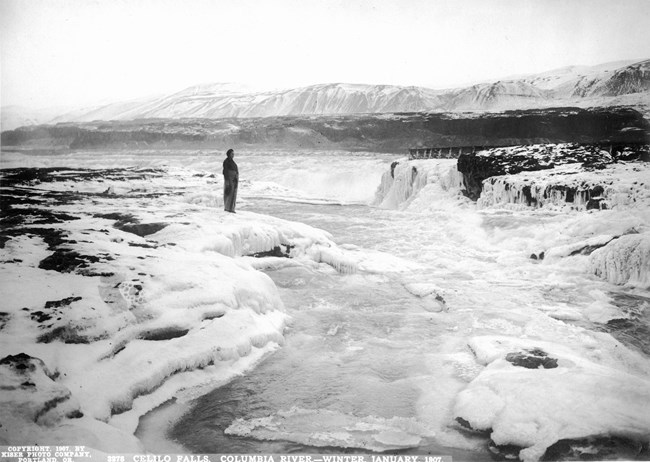Last updated: November 28, 2023
Article
Dams on the Columbia River

Oregon Historical Society
People came from hundreds of miles away to trade at Celilo Falls and the Narrows of the Columbia River. Many people knew this place. Chuck Williams (who is Cascade Chinook) called the Long Narrows “the best fishing spot of all. Countless salmon filled the eddies around these constrictions.”
Yet few people today have ever seen these massive waterfalls.
What happened?
The U.S. government flooded them.
During the 1950s, the U.S. Army Corps of Engineers built The Dalles Dam just downstream of the area, flooding the Narrows and Celilo Falls. The entirety of the falls and rapids are now under water.
Celilo Falls remains a sacred space for many people. Pat Courtney Gold (who is Wasco-Wishram) wrote about how construction of the dam affected her family:
In March 1957, when The Dalles Dam was built, it destroyed The Narrows and our fishing sites. For years afterwards, my mother would not go to Wac'uqs or The Dalles. Her pleasant memories of her childhood and of the family gatherings and fishing events were also lost forever . . .
Today, we are keeping our culture alive. We travel from the reservation back to Wauna [the Columbia River] to fish in our usual and accustomed fishing sites. We still process salmon, some by drying salmon in the traditional way, some by making the killuk [powdered salmon], and some by using the modern method of pressure canning salmon. . . Though the fishing is not as good as it used to be, we still travel from the Warm Springs Reservation to fish during the spring and fall Chinook runs. Some of the elders still recall fishing at The Narrows and share their memories. Soon, they will pass on, and the memories of The Narrows will be forgotten. . . . the stories do not—and cannot—capture the sight, the sound, and the smell of The Narrows; nor the sounds of the excitement of the People during the fishing seasons.
The flooding of the falls is an emotional and economic loss that is still felt by Chinookan- and Sahaptian-speaking people of the Columbia River. For more stories on the intergenerational pain caused by this loss, visit the website of the Columbia River Intertribal Fish Commission.
If you stand on the Oregon side of the river, you can still see the route that so many people used to portage around the falls, but everything else is below the water. What else was lost along with these rapids? How can it be returned?
About this article: This article is part of a series called “Pivotal Places: Stories from the Lewis and Clark National Historic Trail.”
